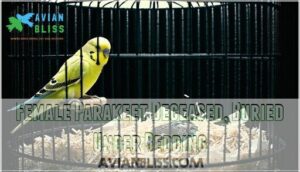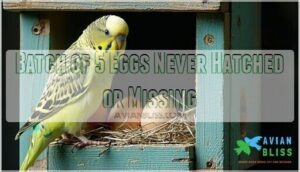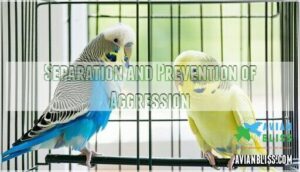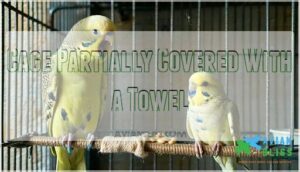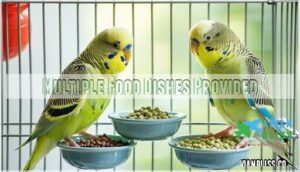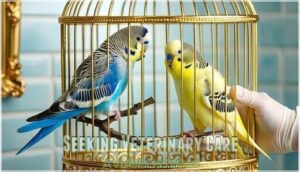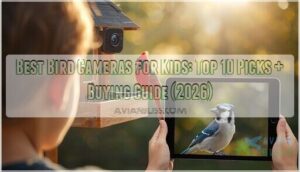This site is supported by our readers. We may earn a commission, at no cost to you, if you purchase through links.

Your male might be protecting a nest site, experiencing seasonal hormone surges, or feeling overwhelmed by mating pressures.
Health issues like illness or nutritional deficiencies can also trigger aggression. Sometimes males become overly possessive of food, toys, or cage space.
Sudden environmental changes or the presence of eggs (even infertile ones) can intensify this behavior. If your female is showing signs of distress or injury, immediate separation is essential.
Understanding the root cause—whether it’s breeding season blues or something more serious—will help you restore peace to your feathered household, addressing the hormonal changes and ensuring a safe environment for both birds, considering their territorial behavior.
Table Of Contents
- Key Takeaways
- Why is My Male Parakeet Attacking My Female?
- Hormonal Changes and Breeding Behavior
- Protecting The Nest and Eggs
- Potential Health Issues
- Separation and Prevention of Aggression
- Cage Environment and Setup
- Seeking Veterinary Care
- Frequently Asked Questions (FAQs)
- Why does my parakeet bite or attack me?
- Do parakeets fight?
- Why are parakeets aggressive?
- Why do female parrots attack a male parrot?
- Why do parakeets and lovebirds fight?
- Why is my female bird suddenly aggressive?
- Why is my male budgie attacking my female budgie?
- Why is my parakeet suddenly aggressive?
- How can you tell if your male parakeet is trying to mate with a female?
- How do I stop my budgies from attacking each other?
- Conclusion
Key Takeaways
- Separate your birds immediately if attacks persist – hormonal surges during breeding season can turn your gentle male into an aggressive defender, and your female’s safety comes first.
- Check for underlying health issues like calcium deficiency in females or illness in males – these medical problems often trigger territorial behavior that looks like simple aggression.
- Reduce breeding triggers by limiting daylight to 8-10 hours and providing multiple food dishes – this minimizes competition and hormonal spikes that fuel attacks.
- Consult an avian vet if environmental changes don’t help – persistent aggression often signals deeper hormonal imbalances or health conditions requiring professional treatment.
Why is My Male Parakeet Attacking My Female?
When you notice your male parakeet attacking your female, several factors could be driving this parakeet aggression.
Hormonal surges during breeding season often trigger territorial male parakeet aggression, especially when females show mating rejection.
This parakeet fighting can stem from pairing incompatibility, where birds simply don’t mesh well together, or resource competition over food, perches, and nesting spots.
Parakeet behavior changes dramatically when breeding instincts kick in.
Males become protective and dominant, while stressed females may exhibit escape behaviors.
Cere color changes often signal hormonal imbalances affecting their interactions.
Stress reduction becomes essential through environmental modifications.
Separate their cages side by side for visual contact while ensuring safety.
Reduce daylight hours to minimize breeding triggers, and provide multiple food dishes to eliminate competition.
Understanding territorial defense strategies can offer insights into these conflicts.
Building trust requires patience and gradual reintroduction.
Monitor both birds’ eating habits and weight closely.
If aggressive episodes persist despite these interventions, consult an avian veterinarian to rule out underlying health issues like calcium deficiency or other medical problems contributing to the conflict.
Hormonal Changes and Breeding Behavior
When your male parakeet suddenly becomes aggressive during breeding season, hormonal surges are likely driving this territorial behavior.
Breeding season transforms gentle males into fierce territorial defenders overnight.
You’ll notice dramatic changes in his demeanor as testosterone levels spike, making him protective of his space and potentially hostile toward your female bird, driven by a strong instinct to defend his territory and mate.
Sudden Onset of Aggression in Male Parakeet
Male parakeet aggression can strike without warning when hormonal surges hit during breeding season.
Your bird’s territorial behavior intensifies as testosterone levels spike, transforming a gentle companion into an aggressive defender.
Environmental stressors like increased daylight hours or new cage additions can trigger this mating behavior.
Understanding your bird’s behavioral history helps with trigger identification, while dietary changes addressing calcium deficiencies may reduce conflict between your feathered pair.
Female Parakeet Exhibiting Escape Behavior
When your female parakeet shows escape behavior, she’s likely responding to mounting parakeet stress from male aggression.
This fearful behavior manifests as frantic movements, avoiding certain cage areas, or pressing against bars.
Environmental stressors and her natural flight instinct intensify these responses.
Make certain cage security prevents injury during panic episodes.
Wing clipping may worsen anxiety, while parakeet compatibility issues suggest potential separation needs.
Cere Color Changes Not Matching Typical Gender Roles
When your male parakeet‘s cere turns brown while your female parakeet displays blue coloring, you’re witnessing cere color changes that signal significant hormonal changes.
These reversed colors indicate hormonal influence disrupting normal breeding behavior patterns.
Genetic factors, dietary impact, and environmental stressors can trigger this plumage confusion.
Such hormonal imbalances often correlate with increased aggression, as your birds’ bodies struggle with conflicting reproductive signals that don’t match their actual sex.
Protecting The Nest and Eggs
When your male parakeet becomes fiercely protective of nesting areas, he may attack your female to guard eggs or potential nesting spots.
This territorial behavior intensifies when males take over incubation duties, especially if previous breeding attempts failed or if the female has died, which can be related to territorial behavior.
Male Parakeet Nesting and Keeping Warm a Single Egg
When your male parakeet suddenly takes on unusual parenting duties during breeding season, it signals significant hormonal changes and territorial behavior.
This role reversal often occurs when males become highly protective of nesting materials and exhibit intense male incubation behaviors toward a single egg.
- Egg warmth maintenance: Males may sit on eggs for hours, attempting chick development despite lower success rates than females.
Understanding these nesting instincts helps explain parakeet aggression patterns.
Female Parakeet Deceased, Buried Under Bedding
When your female parakeet dies unexpectedly and you discover her buried under bedding, you’re witnessing natural burial instinct combined with tragic parakeet aggression.
The cause of death often involves stress-induced complications from persistent attacks or underlying parakeet health issues masked by breeding season behaviors.
This grief behavior demonstrates complex avian emotions while highlighting urgent preventative measures needed.
Post-mortem care requires immediate separation of remaining birds and consultation with an avian veterinarian to prevent future parakeet breeding tragedies through proper parakeet behavior management.
Batch of 5 Eggs Never Hatched or Missing
Five eggs that never hatched typically indicate egg infertility or incubation problems.
When parental neglect occurs, males may engage in egg eating to clear the nest.
Environmental factors like temperature fluctuations disrupt parakeet breeding cycles.
Your male’s parakeet aggression stems from protective instincts around failed parakeet nesting attempts.
Bird mating stress intensifies when reproduction fails, triggering defensive bird aggression behaviors.
Potential Health Issues
Health problems can trigger aggressive behavior in your male parakeet, making medical evaluation essential when attacks persist.
Issues like hormonal imbalances, calcium deficiency in females, or underlying illness often manifest as increased territorial behavior or frustration that leads to fighting, which is why medical evaluation is crucial.
Female Parakeet Eating and Drinking Normally
Observing your female parakeet’s normal eating and drinking habits doesn’t guarantee she’s healthy, especially during periods of parakeet aggression causes. Healthy appetite and proper hydration importance can mask underlying issues like calcium deficiency, which contributes to stress and escape behaviors you’re witnessing.
Key nutritional needs to monitor include:
- Dietary changes that support calcium absorption and reduce hormonal triggers
- Food preferences shifting toward calcium-rich options like cuttlebone or leafy greens
- Parakeet health check indicators beyond appetite, such as energy levels and social behavior
Regular parakeet behavior observation helps identify subtle changes that warrant avian veterinary care, ensuring thorough parakeet observation beyond basic feeding habits.
Male Parakeet Previously Destroyed Eggs
Destructive behavior toward eggs often signals deeper health problems in your male parakeet.
Egg destruction reasons include male frustration during breeding season, hormonal changes, or compromised parental instincts.
This aggressive behavior disrupts normal breeding disruption cycles and indicates territorial behavior issues.
Monitor his diet, environment, and stress levels closely, as re-nesting prevention behaviors suggest underlying nutritional deficiencies or psychological distress requiring immediate attention.
Environmental stressors, such as overcrowding, can lead to protective egg consumption.
Female Parakeet May Have Low Calcium Levels
Calcium deficiency in your female parakeet can trigger aggressive male behavior during breeding season.
When females lack calcium, males become territorial protectors, escalating breeding season aggression.
When females lack proper bone health, they experience egg binding and distress, causing males to become territorial protectors.
- Provide cuttlebone – Essential supplementation options for daily calcium intake
- Add leafy greens – Dark vegetables meet dietary needs naturally
- Monitor egg quality – Soft shells indicate deficiency requiring immediate attention
- Schedule vet checkup – Professional assessment prevents serious complications during breeding
Separation and Prevention of Aggression
When your male parakeet’s aggression escalates beyond normal territorial squabbles, you’ll need to take immediate action to protect your female bird from harm.
Separating the aggressive male creates a safe environment while you work on long-term solutions to restore harmony between your feathered companions.
Separate Aggressive Male From Female Parakeet
When health issues escalate into safety concerns, immediate parakeet separation becomes your priority.
Temporary Housing your aggressive male protects both birds while you address underlying problems like territorial behavior and hormonal changes. You might consider a specialized setup for this purpose.
| Separation Method | Implementation |
|---|---|
| Emergency Cage | Set up separate housing immediately |
| Visual Barriers | Block direct sight lines between cages |
| Supervised Visits | Allow brief, monitored interactions |
| Gradual Reintroduction | Slowly rebuild parakeet bonding |
| Rehoming Options | Consider if parakeet aggression prevention fails |
This cage space strategy gives stressed birds breathing room while you monitor eating habits and plan Supervised Visits for future reconciliation.
Place Cages Side by Side for Visual Contact
Once you’ve separated them, position their cages side by side for visual acclimation. This gradual introduction method allows your male parakeet and female parakeet to see each other without physical contact, reducing stress while maintaining social connection.
Many owners find success by purchasing parakeet acclimation products.
Behavioral observation during this phase helps you monitor parakeet aggression levels and determine when supervised interaction might be possible for improved parakeet bonding.
Reduce Daylight Hours to Deter Breeding Behavior
Photoperiod manipulation offers a powerful tool for managing breeding season hormones and territorial behavior.
Light cycle control helps reduce your male’s aggressive instincts naturally.
Here’s your behavioral modification plan:
- Limit daily light exposure to 8-10 hours using cage covers or room darkening
- Eliminate artificial lighting impact from TVs and electronics during "night" hours
- Maintain consistent schedules for several weeks to allow hormonal regulation
This breeding seasonality approach tackles aggression management at its hormonal source, often showing results within weeks.
Cage Environment and Setup
Your cage setup directly impacts whether your male parakeet will attack your female companion.
The right environment with proper space, resources, and calming elements can reduce territorial disputes and create a peaceful home for both birds.
Parakeets Kept in a Cage With a Cage Protector
Cage protectors can help reduce external stress, but their protector effectiveness depends on proper protector placement and cage size.
You’ll want bird visibility maintained while blocking disturbances. Choose breathable protector material that doesn’t restrict airflow.
Your parakeet cage setup should still allow movement and social interaction. A cage should provide 4000 cubic inches minimum per bird.
Poor cage environment with restrictive protectors can actually increase territorial behavior and aggressive behavior between your birds.
Cage Partially Covered With a Towel
Towel coverage might seem helpful, but it can escalate parakeet aggression through three key problems:
- Reduced Visibility creates anxiety as birds can’t monitor their surroundings for threats
- Trapped Heat builds under fabric, causing stress and potentially triggering territorial behaviors
- Bacterial Growth from damp towel conditions can lead to health issues that worsen aggression
Remove towels gradually to prevent shocking your birds while maintaining their security.
Multiple Food Dishes Provided
Providing multiple feeding stations throughout your cage can substantially reduce competition and resource guarding between your parakeets.
When birds don’t have to compete for food, parakeet aggression often decreases naturally.
This approach guarantees food abundance while meeting each bird’s specific dietary needs.
Consider purchasing various parakeet feeders to accommodate different food types and preferences.
| Setup Element | Benefit | Implementation |
|---|---|---|
| Multiple dishes | Reduces competition | Place 3-4 feeding stations |
| Varied locations | Prevents territorial disputes | Distribute around cage perimeter |
| Different food types | Meets individual preferences | Offer seeds, pellets, fresh foods |
| Adequate spacing | Minimizes confrontation | Keep dishes 6+ inches apart |
| Easy access | Reduces frustration | Position at comfortable perch height |
To ensure a harmonious environment, it’s essential to consider the specific dietary needs of each bird and provide an environment that minimizes competition and confrontation.
By implementing these strategies, you can create a peaceful and healthy environment for your parakeets, reducing the likelihood of aggression and promoting overall well-being.
Seeking Veterinary Care
When your male parakeet’s aggressive behavior persists despite environmental changes, it’s time to consult an avian veterinarian to rule out underlying health issues.
Professional medical evaluation can identify hormonal imbalances, calcium deficiencies, or other physical problems that might be driving the attacks against your female bird, which could be caused by a serious underlying condition.
Vet Visit Recommended if Aggressive Behavior Continues
When aggressive behavior persists despite environmental changes, consult an avian veterinarian immediately. Underlying illnesses often trigger behavioral changes that mimic territorial disputes.
Professional diagnosis through medical tests can identify health issues like hormonal imbalances or nutritional deficiencies causing your bird’s stress.
Here’s what veterinary evaluation reveals:
- Hidden pain making your male parakeet lash out defensively
- Hormones running wild, turning your gentle bird into an aggressor
- Nutritional gaps weakening your female’s ability to cope with attacks
- Infections causing confusion and fear-based reactions
- Reproductive complications triggering protective instincts gone wrong
Your avian veterinarian will recommend specific treatment options based on thorough health assessments, blood work, and behavioral observations.
Monitor Male Parakeet’s Weight and Eating Habits
Weight loss in your male parakeet signals potential health issues driving aggressive behavior.
Monitor his eating habits daily, watching for appetite changes or food aggression around feeding time.
Dietary deficiencies can trigger hormones that worsen attacks on females.
Sudden weight drops often indicate metabolic issues requiring immediate attention.
Track his food intake carefully—healthy male parakeets maintain consistent appetites even during territorial disputes.
Ensure Budgies Have Access to Veterinary Care
Regular checkups with an avian veterinarian are essential for your parakeets’ well-being.
An experienced vet can identify health problems like calcium deficiency that trigger aggression, examine any eggs present, and provide specialized bird diets designed to meet your birds’ needs.
Preventative bird medicine catches issues before they escalate into serious conflicts. Bird health monitoring through professional veterinary care guarantees you’re not missing subtle signs of illness.
Profit-driven breeding can also lead to compromised budgie health, making regular checkups even more important.
When emergency bird care becomes necessary, having an established relationship with an avian health specialist makes all the difference in resolving behavioral problems quickly.
Frequently Asked Questions (FAQs)
Why does my parakeet bite or attack me?
Your parakeet might bite due to territorial behavior, hormonal changes during breeding season, fear, or health issues.
They’re defending their space or expressing discomfort.
Check for illness signs and verify proper cage setup to address potential health issues.
Do parakeets fight?
Yes, parakeets do fight.
These social birds establish pecking orders and can become aggressive over territory, resources, or during breeding season.
Males often clash with females due to hormonal changes, mating rejection, or space competition.
Fights aren’t uncommon in multi-bird households.
Why are parakeets aggressive?
Aggression stems from territorial instincts, hormonal surges during breeding season, jealousy over attention, mating frustration, or health issues.
You’ll notice increased conflict when birds compete for space, resources, or dominance within their social hierarchy.
Why do female parrots attack a male parrot?
Surprisingly, 99% of parrot aggression stems from food, space, or mating disputes.
Female parrots attack males when they’re protecting territory, rejecting unwanted advances, experiencing hormonal changes, or feeling stressed by overcrowding in their shared space, often due to space issues.
Why do parakeets and lovebirds fight?
Birds clash over territory, hormones, and resources.
You’ll see fights during breeding season when testosterone peaks, over food dishes, or when establishing pecking order.
Stress, inadequate space, and incompatible personalities also trigger conflicts between your feathered friends, often leading to conflicts.
Why is my female bird suddenly aggressive?
Picture your feathered friend‘s world turned upside down—sudden female aggression often stems from hormonal changes during breeding season, territorial disputes, health issues, or stress from environmental changes you’ve made recently.
Why is my male budgie attacking my female budgie?
Your male budgie’s attacking due to territorial behavior, hormonal changes during breeding season, or resource competition.
Separate them temporarily, provide multiple perches and food dishes, and make certain adequate cage space to reduce conflicts and promote a more peaceful environment with adequate space.
Why is my parakeet suddenly aggressive?
Sudden aggression, territorial disputes, and hormonal surges often trigger your parakeet’s behavioral changes.
You’ll notice increased dominance during breeding season, stress from environmental changes, or underlying health issues causing irritability and unpredictable outbursts, which can be linked to hormonal surges.
How can you tell if your male parakeet is trying to mate with a female?
You’ll notice your male getting frisky when he starts head-bobbing, regurgitating food for her, preening her feathers.
Or doing that signature parakeet "mating dance" with wing-flapping and excited chirping around her.
How do I stop my budgies from attacking each other?
While separating them feels counterproductive, temporarily housing your budgies in different cages prevents injury and reduces stress.
Gradually reintroduce them by placing cages side-by-side, providing multiple food stations, and enriching their environment with distracting toys.
Conclusion
Like feathered gladiators in an ancient colosseum, your parakeets may be locked in territorial combat that threatens their peaceful coexistence.
Understanding why your male parakeet is attacking your female requires patience and careful observation. Hormonal surges, nesting instincts, health issues, and environmental stress can all trigger aggressive behavior.
Quick separation prevents injury while you identify the root cause.
Adjusting lighting, providing multiple resources, and consulting an avian veterinarian will help restore harmony to your avian household.
- https://www.omlet.us/guide/parakeets/parakeet_behaviour/aggressive_behavior/
- https://lafeber.com/pet-birds/questions/aggressive-female-budgie/
- https://www.talkbudgies.com/threads/male-budgie-forcing-female-to-mate.426073/
- https://www.youtube.com/watch?v=3lf17yL-bHU
- https://www.reddit.com/r/budgies/comments/pjwif9/help_budgie_fhas_started_to_be_aggressive_she/



